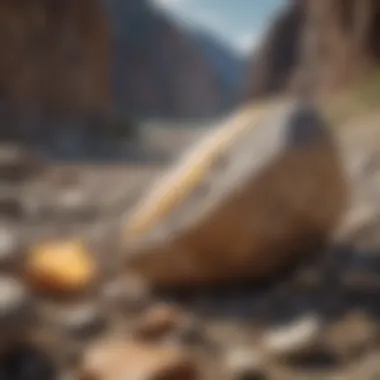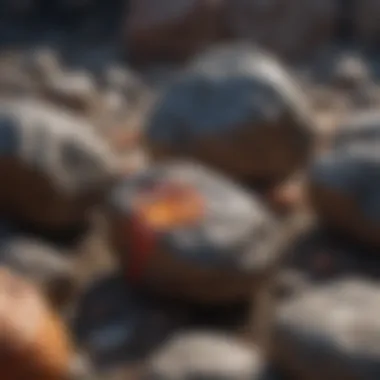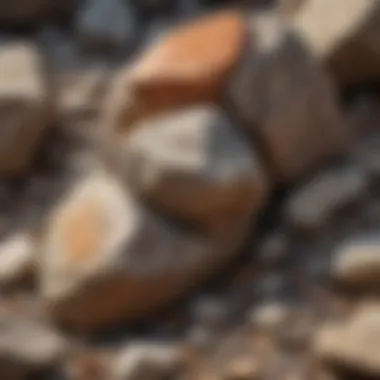The Rock Cycle: Understanding Earth's Dynamic Processes


Intro
The rock cycle is a complex set of processes that govern the transformation of rocks. Understanding these processes is central not only for geology but also for collectors and enthusiasts. This article aims to unravel the intricate characteristics of igneous, sedimentary, and metamorphic rocks, emphasizing how they interact within the cycle. The rock cycle is not static; it is dynamic and influenced by various geological activities.
Featured Collectible of the Month
Overview
Rock collectors often seek unique specimens that tell a story of Earth's history. This month, we spotlight a fascinating specimen, the ammonite, a prehistoric marine mollusk known for its spiral shell. Ammonites play a crucial role in understanding sedimentary processes and offer insights into the environment millions of years ago. Collectors value these fossils due to their intricate designs and rich history.
Historical Significance
The ammonite first appeared around 400 million years ago and became extinct about 65 million years ago. Its fossilized remains can be found in many sedimentary rock layers, indicating their widespread existence during the Mesozoic era. Collecting ammonites isn't just about aesthetics; it reflects the significant evolutionary changes that occurred on Earth. Their presence in rock layers serves as important markers for geologists studying past environmental conditions.
Identification Techniques
Visual Characteristics
Identifying an ammonite requires a keen eye. Here are some visual traits to look for:
- Spiral Form: Ammonites have a recognizable coiled shell.
- Suture Patterns: Look for intricate patterns on the shell where the chambers are divided.
- Coloring: Fossils can show a range of colors depending on their mineral content and the conditions in which they were preserved.
Resources for Identification
For rock and fossil collectors seeking to improve their skills in identifying specimens, several resources are available:
- Books: Titles such as "Fossils: A Key to the Past" provide detailed descriptions and images.
- Online Communities: Websites like Reddit have forums where collectors share knowledge.
- Local Museums: Often feature workshops or exhibits focusing on fossils and identification techniques.
Understanding these identification techniques expands the collector's ability to appreciate the geological history represented by each specimen. The rock cycle, through its processes, continually shapes both the earth and the collectibles we find.
Prelims to the Rock Cycle
The rock cycle serves as a pivotal concept in the field of geology. It elucidates the dynamic nature of Earth's crust, showcasing how various rock types continuously transform through geological processes. Understanding the rock cycle is essential for comprehending Earth's history, the formation of landscapes, and the creation of natural resources. This article dissects the intricate components of this cycle, emphasizing the significance of each stage in the transformation from one rock type to another.
The Concept of the Rock Cycle
The rock cycle is fundamentally a model that describes the transitions between three main types of rocks: igneous, sedimentary, and metamorphic. This cycle is non-linear, meaning that rocks can move through various stages depending on environmental conditions. For instance, an igneous rock can weather into sediments, which can then compact and cement to form sedimentary rock. Over time, sedimentary rock may undergo metamorphism due to heat and pressure, transforming once again into a different rock type.
This model does not simply focus on the classification of rocks; it embraces the processes that lead to their transformations. Weathering, erosion, metamorphism, and crystallization are crucial in defining how rocks change. Moreover, plate tectonics play a significant role, adding an additional layer of complexity to the cycle. Understanding these processes gives insight into the geological history and dynamic nature of our planet.
Importance of the Rock Cycle
Grasping the significance of the rock cycle is crucial for several reasons. First, it illuminates the history of Earth. Each rock contains stories of past environments, climate changes, and geological events. By studying rocks, scientists can reconstruct historical climate patterns, volcanic activity, and the formation of continents.
Additionally, the rock cycle has practical implications. It affects the distribution of natural resources like minerals, oil, and gas. Knowledge of rock formations can lead to better exploration techniques for these resources, which are vital for economic development.
For rock and fossil collectors, understanding the rock cycle enhances their ability to identify specimens. Collectors gain insights into where specific rocks may be found and their historical significance. Here are some key benefits for collectors related to the rock cycle:
- Identification of Rock Types: Knowing how rocks form helps in classification.
- Collection Techniques: Understanding geological processes can improve collection methods.
- Preservation of Specimens: Knowledge of rock formation aids in maintaining specimens in optimal conditions.
"The rock cycle is not merely a concept; it is a narrative that illustrates the Earth’s continuous story of transformation and resilience."
Overall, the rock cycle is a fundamental aspect of geology. Its implications resonate across various fields, influencing our understanding of the Earth and its processes.
Types of Rocks in the Rock Cycle
The discussion on the different types of rocks is crucial in understanding the rock cycle. Each category of rock plays a unique role in the geological processes that govern Earth's surface and interior. Recognizing igneous, sedimentary, and metamorphic rocks allows readers to appreciate how these classifications interconnect through various environmental influences, and they highlight the dynamic nature of our planet's geology.
Igneous Rocks
Formation processes
Igneous rocks form from the cooling and solidification of molten rock, known as magma or lava. This formation can happen either beneath the Earth's surface, creating intrusive igneous rocks, or on the surface through volcanic activity, resulting in extrusive types. This process is significant, as it illustrates how geological conditions influence rock formation and the eventual recycling of materials in the rock cycle. A unique feature of igneous rock formation is that it can occur rapidly or slowly. Rapid cooling often leads to finer grains, while slow cooling encourages larger crystals. This affects how igneous rocks can be identified and classified.
Key characteristics
The key characteristics of igneous rocks include texture, mineral composition, and color. The texture greatly influences how a rock appears and feels, displaying a variety of grain sizes that imply different cooling rates. Understanding these characteristics is essential for geologists and enthusiasts alike because it aids in identifying rock types and their origins. A unique aspect of these rocks is their use in construction and ornamentation. They can be very durable, which is beneficial, especially in architectural applications.
Examples of igneous rocks
Common examples of igneous rocks include granite, basalt, and rhyolite. Granite, an intrusive type, often features large crystals and a light color due to its high quartz content. Basalt, an extrusive rock, is denser and darker. These examples serve a practical purpose in various fields such as construction, landscaping, and geology. The unique mineral makeup provides insights into the conditions under which these rocks developed, presenting value for research and collection.
Sedimentary Rocks
Formation mechanisms
Sedimentary rocks are formed through the accumulation and cementation of mineral and organic particles. This can happen in various environments, including rivers, lakes, and oceans. The formation mechanisms showcase how sediments transform under pressure and time, often creating layers that reveal Earth's history. A characteristic feature is that they frequently include fossils, which provide crucial insight into past life forms. This helps collectors understand the evolutionary timeline documented in these rocks.


Key characteristics
The features of sedimentary rocks include layering, grain size, and composition. These aspects reveal how and where the sediment was deposited, informing understanding of past environments. Their significance also extends to how they are often used as resource deposits, containing coal, oil, and natural gas. The unique property of containing fossils makes them particularly valuable to paleontologists and collectors.
Examples of sedimentary rocks
Examples of sedimentary rocks include sandstone, limestone, and shale. Sandstone, composed mainly of sand-sized grains, showcases the erosional history of its source areas. Limestone forms primarily from calcite, often containing fossils. These examples highlight important resources, such as building materials and energy sources. They offer insights into sediment transport and deposition processes, making them essential in geological studies and collections.
Metamorphic Rocks
Formation processes
Metamorphic rocks arise from the alteration of existing rocks due to heat, pressure, and chemically active fluids. This process, known as metamorphism, can transform both igneous and sedimentary rocks into entirely new types. Understanding the formation processes enlightens collectors and geologists on how environmental factors affect rock characteristics. A unique feature is that the original rock's structure can influence the resulting metamorphic rock type, providing a direct link to its heritage.
Key characteristics
Key characteristics of metamorphic rocks include foliation, texture, and mineral composition. Foliation refers to the alignment of minerals due to directional pressure, impacting their appearance. These elements are crucial for identification and understanding the conditions under which metamorphism occurred. The unique aspect of metamorphic rocks is that they often retain textures and patterns from their parent rocks, making them fascinating to study and collect.
Examples of metamorphic rocks
Common examples of metamorphic rocks include schist, gneiss, and marble. Schist is noted for its pronounced foliation, while gneiss exhibits banding due to high-grade metamorphism. Marble, derived from limestone, is prominent in art and architecture. These examples allow collectors to appreciate the transformation and history of materials found in nature. They illuminate the processes of change that characterize the rock cycle, demonstrating its importance comprehensively.
Processes in the Rock Cycle
The rock cycle comprises critical processes that transition rock types against a backdrop of Earth’s ongoing evolution. Understanding these processes enables a fuller appreciation of geology. Each process contributes uniquely to the formation, transformation, and recycling of rocks. Observing these dynamics not only enhances our knowledge of Earth's materials but also informs various practical applications in geological studies.
Weathering and Erosion
Definition and significance
Weathering and erosion represent foundational processes within the rock cycle. They serve to break down rocks into smaller particles and transport them. This breakdown occurs on the surface, driven by environmental forces like wind, water, and temperature changes. Its significance lies in the formation of soil and sediment, which are vital for sustaining life.
One key characteristic of weathering is its dual nature. Physical weathering physically breaks rocks apart without altering their chemical structure. This contrasts with chemical weathering, which involves chemical reactions that lead to a change in mineral composition. Both types play essential roles in nutrient cycling and landform development.
A unique feature of this process is its influence on sedimentary rock formation. The smaller particles created from weathering can accumulate over time, forming layers that develop into sedimentary rocks. This aspect demonstrates the interconnectedness of different rock types in the cycle.
Types of weathering
Types of weathering fall primarily into two categories: physical and chemical. Physical weathering includes mechanical breakdown through processes like freeze-thaw cycles or abrasion. In contrast, chemical weathering incorporates reactions such as oxidation or hydrolysis.
The key characteristic of physical weathering is its role in enlarging fractures and decomposing rocks without modifying their chemistry. This can be beneficial for rock collectors since it reveals the physical properties of rocks more clearly.
A unique aspect of this is that while physical weathering promotes fragmentation, it does little to change the rock's fundamental characteristics. This has advantages and disadvantages. On one hand, it preserves much of the mineralogy. On the other hand, it does not facilitate the formation of new minerals, which may be required for certain geological studies.
Role in sedimentary rock formation
Weathering and erosion play a vital role in sedimentary rock formation. The disintegration of existing rocks leads to the generation of sediments. These sediments then accumulate in various environments, such as river beds or ocean floors. Over time, they become compacted and cemented to form sedimentary rocks.
This process illustrates the cycles inherent in the rock cycle. It highlights how raw materials originating from older rocks contribute to the creation of new rock forms. The sedimentary layers also provide valuable geological records, which are essential for understanding the history of the Earth.
Diagenesis
Understanding diagenesis
Diagenesis refers to the physical and chemical processes that sediment undergoes after deposition. It transforms loose sediments into solid sedimentary rock. This understanding is crucial for interpreting the geological history of an area.
The key feature of diagenesis is that it happens at relatively low temperatures and pressures. This differentiates it from metamorphism, where higher temperatures and pressures are prevalent. Studying diagenesis is beneficial because it helps reveal conditions of sedimentary environments, which can be crucial for resource exploration.
One unique feature of diagenesis is its role in preserving fossils within sedimentary layers. As sediments solidify, they may encapsulate organic material, contributing to paleontological studies.
Processes involved
Several processes are involved in diagenesis, including compaction, cementation, and recrystallization. Compaction occurs as overlying materials exert pressure on sediments, reducing pore space. Cementation is the binding of particles through minerals precipitating from groundwater.
The important characteristic of these processes lies in their ability to produce solid rock from unconsolidated material. This transformation is vital for rock formation and has a wide range of implications in resource development.
One advantage of studying diagenetic processes is the insights they provide into subsurface environments. This can be beneficial for oil and gas exploration where understanding rock formations leads to successful resource extraction.
Impact on sedimentary rocks
Diagenesis profoundly impacts the characteristics of sedimentary rocks. It influences porosity, permeability, and overall strength. These factors determine how fluids move through rock, impacting groundwater flows and hydrocarbon migration.
The key characteristic of this impact is its significance in both natural and human domains. For example, strong diagenetic controls enhance reservoir quality for oil and natural gas. Conversely, weak diagenesis might lead to lower quality rocks, affecting extraction viability.
This influence highlights that the understanding of diagenesis is crucial for both geologists and resource managers. It informs strategies for prospecting and environmental assessments.
Metamorphism
Types of metamorphism


Metamorphism refers to the alteration of rocks due to pressure, temperature, and mineral conditions. It occurs in several types, each defined by the conditions under which it takes place.
Key types include contact metamorphism, occurring due to nearby molten rock, and regional metamorphism, caused by tectonic forces over large areas. Each type provides insights into the geological processes shaping the Earth's crust.
Understanding the different metamorphic types is beneficial for rock collectors, as it informs the identification of mineral properties and the genesis of rocks. Additionally, this knowledge can guide collectors on where to locate specific metamorphic rocks.
Factors affecting metamorphism
Factors affecting metamorphism include temperature, pressure, and the presence of fluids. Higher temperatures and pressures often lead to more extensive metamorphic changes.
The major characteristic of these factors is their interdependency. For instance, increased pressure with high temperatures typically enhances mineral stability. This results in the formation of unique textures and mineral compositions.
Understanding the effects of these factors is essential. It helps geologists predict how specific rocks will respond to environmental changes, influencing mining and resource management decisions.
Examples of metamorphic changes
Prominent examples of metamorphic changes include the transformation of shale into schist and limestone into marble. These transitions illustrate how original rock types evolve under specific conditions.
The characteristic of such changes emphasizes the importance of understanding mineralogical and structural components. For collectors, knowledge of how these transformations occur helps in identifying and categorizing their specimens.
The distinct features arising from metamorphic processes, such as foliation and banding, also serve to enhance aesthetic value. However, the rarity of some metamorphic rocks can present challenges in obtaining them for collections.
Melting and Crystallization
Conditions for melting
Melting is essential in the rock cycle. It transforms solid rock into molten magma. Key conditions include temperature increases and pressure decreases, promoting melting.
The significant characteristic of these conditions is their interplay. As tectonic activities shift rocks closer to the Earth’s heat sources, melting can occur. Understanding these conditions informs the prediction of volcanic activity and rock formation.
Anticipating melting processes can lead to practical advantages in forecasting eruptions, indirectly protecting lives and property.
Formation of magma
The formation of magma is a critical component of the rock cycle. Magma forms when temperatures within the Earth reach a solidus or melting point for particular rocks.
The important characteristic of magma formation is the presence of volatile components, such as water and carbon dioxide. These volatiles can reduce the melting point, impacting the composition and behavior of resulting magma. Knowledge of magma behavior helps geologists understand potential eruption patterns and hazards.
Crystallization processes in igneous rock formation
Crystallization describes how magma cools and forms solid rock, known as igneous rock. Rapid cooling can result in small crystals, while slow cooling allows larger crystals to develop.
The key feature here is that crystallization conditions significantly influence the rock’s final texture. This has implications for rock classification and study.
Collectors benefit from understanding these processes, as they directly affect the type and appearance of igneous rocks. Gaining knowledge in this area enables the identification of various rock types during fieldwork or collection efforts.
Understanding the processes in the rock cycle enhances our insight into the Earth’s past and informs our approach to resource exploration. By grasping these processes, rock collectors can make informed decisions regarding their collections.
The Role of Plate Tectonics
Plate tectonics plays a crucial role in the rock cycle. It connects the movement of Earth's plates with the formation and transformation of different rock types. This section will focus on understanding the basic concepts of plate tectonics and how these processes influence the rock cycle. Knowing how plates interact highlights not only geological phenomena but also impacts on ecosystems, climate, and Earth’s history.
What are Plate Tectonics?
The theory of plate tectonics explains the movement of Earth's lithosphere on the underlying asthenosphere. The lithosphere is broken into several tectonic plates, which float on a viscous layer of molten rock. These tectonic plates can be oceanic or continental. Their movement shapes Earth's surface and leads to various geological activities.
- Key Characteristics of Plate Tectonics:
- Plates can diverge, converge, or transform.
- Interaction of plates causes earthquakes, volcanic eruptions, and mountain building.
Understanding the function of plate tectonics is significant as it provides insights into geological processes that occur deep within the Earth, which in turn shape its exterior.
Tectonic Processes Affecting the Rock Cycle
Tectonic processes play essential roles in the rock cycle. Different types of tectonic boundaries contribute uniquely to rock formation and transformation. Below are three main tectonic processes: subduction zones, rift zones, and transform faults.
Subduction Zones
Subduction zones occur when one tectonic plate moves under another, sinking into the mantle. This process significantly contributes to the rock cycle by recycling oceanic crust back into the Earth’s interior.
- Key Characteristic:
- High-pressure environments lead to the formation of metamorphic rocks.
Subduction zones are vital for understanding how oceanic plates transform into continental materials, demonstrating a critical aspect of geological recycling.
Rift Zones


Rift zones form where tectonic plates pull apart, allowing magma to rise and create new crust. This phenomenon directly contributes to the generation of igneous rocks.
- Key Characteristic:
- These zones are generally associated with volcanic activity.
Rift zones provide valuable insights into how new rocks are formed from molten material, adding to the overall composition of Earth.
Transform Faults
Transform faults occur when two tectonic plates slide past each other horizontally. This movement leads to significant stress in the Earth's crust, which may result in earthquakes.
- Key Characteristic:
- They do not create or destroy crust; rather, they change the form of rocks.
Transform faults emphasize the dynamic nature of the Earth's surface, showing how existing rock types can be deformed and transformed without new material being added or removed.
In summary, the role of plate tectonics is fundamental to understanding the rock cycle. Each tectonic process contributes uniquely to the formation and transformation of igneous, sedimentary, and metamorphic rocks, thereby influencing Earth’s geological history and its evolution.
Implications of the Rock Cycle
The rock cycle serves as a crucial framework for understanding the earth's dynamic processes. It connects various geological events such as formation, transformation, and destruction of rocks. Recognizing these implications allows us to appreciate not only the physical changes occurring around us but also the long-term effects on our planet's environment and resources.
Understanding Earth’s History
The solid rocks that form our planet carry the memories of its past. Geological formations such as mountain ranges or sedimentary layers tell stories of ancient environments and climatic conditions. By studying the rock cycle, researchers can reconstruct the geological history of Earth. Each rock type offers insight into the conditions under which it was formed. This is essential for understanding shifts in habitats, global climate dynamics, and even biological evolution over millions of years.
Impact on Ecosystems
The processes within the rock cycle influence ecosystems directly. For example, the weathering of rocks contributes to soil formation, which is vital for plant life. Soil composition affects the types of vegetation that can thrive, which in turn supports various animal life. When rocks metamorphose or are subjected to erosion, these changes can alter landscapes. Healthy ecosystems depend on the stability of these geological processes. Disruptions can lead to habitat loss and impact biodiversity.
Relevance to Collectors and Enthusiasts
Collectors and enthusiasts play a significant role in promoting interest in geology through various activities that revolve around the rock cycle. Their passion for rocks and minerals extends to understanding different types and their own unique stories.
Identifying rock types
Identifying rock types is essential for enthusiasts. This skill enhances appreciation for the characteristics of each rock. Knowing how to differentiate between igneous, sedimentary, and metamorphic rocks reduces confusion when collecting. Each type has distinct properties that reflect its formation history. Practitioners often develop methods to recognize differences in texture, color, and mineral composition. This expertise increases the value of their collections.
Techniques for collection
Collectors use various techniques for gathering their specimens. Many start by visiting local geological formations or digging sites. Fieldwork is often the most rewarding aspect of collecting. These experiences allow enthusiasts to uncover unique specimens unavailable in stores. However, respecting local regulations and geological preservation guidelines is important during this process.
Preserving geological specimens
Properly preserving geological specimens ensures their longevity. It involves cleaning, labeling, and storing rocks to prevent damage. This method is beneficial for both display and educational purposes. Knowledge of safe preservation techniques allows collectors to maintain their collections without losing important information about the rocks’ origins. This aspect also extends further into scientific study, giving insights into conditions necessary for maintaining geological façades.
Future of Rock Cycle Studies
As we advance into a new era of scientific discovery, understanding the future of rock cycle studies proves crucial. This field not only helps illuminate the intricate processes that govern Earth’s geological features but also plays a significant role in various scientific domains. The evolving nature of this field may enhance our comprehension of geological events, ultimately benefiting diverse applications such as resource management, environmental protection, and even climate studies.
Technological Advances
Recent advancements in technology have fundamentally transformed the way geologists study the rock cycle. Sophisticated tools, like satellite imaging and remote sensing, allow for real-time observation of geological changes on Earth's surface. These technological innovations enable researchers to monitor sediment movement, volcanic activity, and tectonic shifts with greater accuracy than ever before.
Additionally, the advent of computer modeling techniques facilitates a predictive understanding of geological processes. For example, by employing simulation software, scientists can recreate the dynamics of the rock cycle, forecasting how various factors might interact over time. These models serve as critical tools for understanding past geological events and predicting future occurrences, which can assist in disaster planning and natural resource management.
Ongoing Research Initiatives
Ongoing research in the field of rock cycle studies continues to unveil new insights that reshape our understanding of Earth’s geological history. Initiatives in fields like geochemistry and petrography help delineate rock formation processes more clearly. These studies also reveal how human activity influences geological processes. For instance, the extraction of resources and environmental degradation are vital subjects being examined, emphasizing a need for sustainable practices.
Moreover, interdisciplinary collaborations among geologists, ecologists, and climate scientists are fostering a more integrated approach to studying the rock cycle. Such partnerships aim to connect geological processes with ecological systems, contributing to a more comprehensive understanding of how these domains interrelate. Ultimately, this combined effort may lead to more holistic solutions to pressing environmental issues.
"Research in the rock cycle is not just about understanding rocks; it's about understanding the dynamic processes that shape our planet's future."
By embracing technological advances and supporting ongoing research initiatives, the future of rock cycle studies holds significant promise. This evolving field will continue to contribute valuable knowledge that impacts various disciplines and informs both scientific and public policy.
Culmination
Understanding the rock cycle is essential for grasping the dynamic processes that shape our Earth. The rock cycle illustrates how rocks undergo constant transformation through various geological actions, including weathering, erosion, and tectonic movements. This cycle is not just an academic concept; it's crucial for those interested in geology, paleontology, and environmental science. By realizing the interconnections between different rock types and the processes that affect them, both collectors and enthusiasts can appreciate the complexities of geological formations and their histories.
Recap of Key Concepts
The rock cycle encompasses three primary rock types: igneous, sedimentary, and metamorphic.
- Igneous rocks form from cooling magma and feature a crystalline structure.
- Sedimentary rocks arise from the compaction of sediments, offering insights into Earth’s past environments.
- Metamorphic rocks undergo transformation due to pressure and heat, altering their original form.
This cycle emphasizes not only the nature of each rock type but also the processes they endure to evolve into different forms. Understanding these concepts aids in appreciating the geological history of our planet and its influence on current ecosystems.
Final Thoughts on the Rock Cycle
"To understand rocks is to understand the Earth itself."
This exploration of the rock cycle encourages us to further investigate and appreciate the intricate relationships among the various internal and external forces acting upon our planet. It is a journey worth taking both for academic purposes and personal interest.



